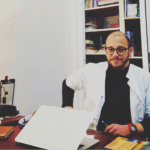Where body and mind meet: The crossroads of psychomotricity
Psychomotricity is a unique discipline that interweaves the body, thought, emotions, and interpersonal relationships. Positioned at the intersection of medical sciences, the humanities, and education, it thrives in a fertile in-between space: that of the psychological and the physical, the objective and the subjective. This article offers a comprehensive reexamination of the history of psychomotricity through five complementary lenses—historical, psychomotor, neurological, psychological, and sociological—to explore how this discipline emerged, evolved, and became institutionalized, all while remaining fundamentally interdisciplinary and human-centered.
Historical perspective: From ancient philosophy to institutional recognition
The first traces of thought integrating mind and body date back to Antiquity. In his dialogues, Plato already alludes to the idea that soul and body are closely linked, although he still views the soul as superior. Aristotle, taking a more empirical approach, develops a more unified vision: body and soul form a single entity—an embodied soul.
However, the Middle Ages and the early modern era witnessed the rise of Cartesian dualism (Descartes, 17th century), which imposed a radical separation between the body (as a measurable object) and the soul or mind (as an immaterial reality). This philosophical rupture hindered the emergence of a holistic understanding of the human being for centuries.
The 19th century marked a turning point. With the rise of experimental medicine (Claude Bernard), the birth of neurology (Jean-Martin Charcot), psychiatry (Philippe Pinel, Jean-Étienne Esquirol), and special education (Édouard Séguin, Maria Montessori, Ovide Decroly), researchers began to examine the links between motor development, cognition, and behavior. These early contributions laid the groundwork for therapeutic approaches to movement, especially in the context of developmental disorders.
World War II was a pivotal period. The neurological and psychological aftermath of war-related injuries (brain trauma, combat neuroses) forced healthcare professionals to rethink the mind-body relationship. In France, pioneers such as Julian de Ajuriaguerra, Henri Wallon, André Bullinger, and Jean Bergès laid the foundations of modern psychomotricity by integrating neurodevelopmental, psychodynamic, and pedagogical insights.
The official recognition of psychomotricians as a profession in 1974, marked by the creation of a national diploma in France, was a major milestone in its institutionalization. Since then, the field has continued to grow through clinical practice, academic research, and professional training.
🔗 Read also: The moving mind: Why psychomotricity builds more than muscles
Psychomotor perspective: the lived body as a medium of expression
At the heart of psychomotricity lies a central premise: the body is not merely a biological object—it is a lived body, rich with meaning, memory, and relationships. It serves as both the foundation of personal identity and the interface through which we relate to the world.
Some of the core concepts in psychomotricity include:
- Body schema: the mental representation an individual has of their own body.
- Body image (as conceptualized by Françoise Dolto): the subjective, emotional, and symbolic experience of being in one’s body.
- Muscle tone: the level of muscular tension, often linked to emotional states.
- Laterality, space-time orientation, rhythm, fine and gross motor skills, among others.
Psychomotor interventions—such as relaxation techniques, motor circuits, sensory play, expressive movement, or theatrical embodiment—aim for psychocorporal integration, where gesture becomes a vehicle for symbolic expression. Children, for instance, often express emotions and inner conflicts through bodily movement before they acquire verbal language.
Thus, psychomotricity operates within educational, therapeutic, and preventive frameworks, depending on the context and the individual’s needs.
Neurological perspective: From motor function to brain plasticity
From a neurological standpoint, psychomotricity draws on developmental neuroscience, which has demonstrated that the brain is plastic—that is, capable of being reshaped by experience.
Voluntary movement, postural adjustment, and sensorimotor coordination are made possible by intricate neural circuits involving:
- The motor and premotor cortices
- The cerebellum (for coordination and movement regulation)
- The basal ganglia
- The vestibular system (for balance)
- Associative areas (for multisensory integration)
Disorders such as dyspraxia, autism spectrum disorders (ASD), or attention deficit hyperactivity disorder (ADHD) often stem from disruptions within these systems. In such cases, psychomotricity offers a holistic approach, where meaningful and repeated movement can promote functional neural reorganization.
Unlike physiotherapy, which focuses primarily on motor function, or occupational therapy, which targets autonomy in daily living, psychomotricity integrates emotion, relational context, and the subjective experience of the body.
🔗 Explore further: From hysteria to science: The legacy of Jean-Martin Charcot
Psychological perspective: The body as a site of conflict and symbolism
In psychomotricity, the body is also a psychological space. Influenced by psychoanalysis (notably Dolto, Anzieu, Winnicott), developmental psychology (Piaget, Wallon), and clinical psychology, the field recognizes the body as a bearer of unconscious conflicts and symbolic meaning.
Children, for example, may express internal conflicts through physical symptoms—coordination issues, inhibition, agitation, or somatic complaints. In such cases, the body becomes a medium of expression, a form of nonverbal language.
Psychomotor practice offers a secure and containing environment through bodily play, symbolic mediation, and the integration of movement with speech. This allows emotions to be expressed and transformed.
For adults dealing with trauma, chronic illness, or psychiatric conditions, the body may be experienced as alien, fragmented, or abandoned. Psychomotor therapy facilitates the process of reclaiming the body, fostering reconciliation with one’s physical self, and rebuilding self-esteem.
Sociological perspective: The body against norms and marginalization
Psychomotricity also challenges societal norms surrounding the body and confronts various forms of exclusion. In contemporary societies that prioritize performance, efficiency, and aesthetic ideals, certain bodies are marginalized—those that are disabled, aging, or in distress.
Psychomotricity seeks to give voice to these silent bodies, to make the invisible visible, and to affirm the expressive potential even in individuals with severe impairments (such as multiple disabilities, dementia, or profound autism).
It embraces an ethic of inclusion, humanity, and even resistance in the face of a neoliberal system that often commodifies the body. Furthermore, psychomotricity takes into account the broader life context: poverty, migration, violence, social isolation, and precarious living conditions.
Practices also adapt to gender, cultural background, and personal values, requiring an ongoing posture of openness and flexibility.
🔗 Discover more: Animal magnetism: Mesmer’s intuitive glimpse into the unconscious
A discipline fueled by creative tension
Psychomotricity stands at a crossroads, continually evolving. It rejects simplistic dualisms (body/mind, care/education, normal/pathological) in favor of a complex, integrated, and embodied understanding of the human subject.
In a world increasingly fragmented, medicalized, and technicized, psychomotricity serves as a vital reminder: we are thinking, feeling, and acting bodies. It promotes a clinical approach that values lived movement, embodied time, and subjectivity—at its core, a profoundly humanistic vision.
References
Anzieu, D. (1985). Le Moi-peau. Paris : Dunod.
Bullinger, A. (2004). Le développement sensori-moteur de l’enfant. Toulouse : Érès.
Le Breton, D. (2010). La sociologie du corps. Paris : Presses Universitaires de France.
Panksepp, J. (1998). Affective neuroscience: The foundations of human and animal emotions. New York, NY: Oxford University Press.
Varela, F. J. (1993). L’inscription corporelle de l’esprit: Sciences cognitives et expérience humaine. Paris : Seuil.
Wallon, H. (1942). De l’acte à la pensée. Paris : Flammarion.
Winnicott, D. W. (1971). Jeu et réalité : L’espace potentiel. Paris : Gallimard, 1975. (Éd. originale : Playing and Reality, 1971)

Saad Chraibi
Psychomotor Therapist
• A graduate of Mohammed VI University in Casablanca, currently practicing independently in a private clinic based in Casablanca, Morocco.
• Embraces a holistic and integrative approach that addresses the physical, psychological, emotional, and relational dimensions of each individual.
• Former medical student with four years of training, bringing a solid biomedical background and clinical rigor to his psychomotor practice.
• Holds diverse professional experience across associative organizations and private practice, with extensive interdisciplinary collaboration involving speech therapists, psychologists, neuropsychologists, and other healthcare professionals.
• Specializes in tailoring therapeutic interventions to a wide range of profiles, with a strong focus on network-based, collaborative care.
• Deeply committed to developing personalized therapeutic plans grounded in thorough assessments, respecting each patient’s unique history, pace, and potential, across all age groups.







